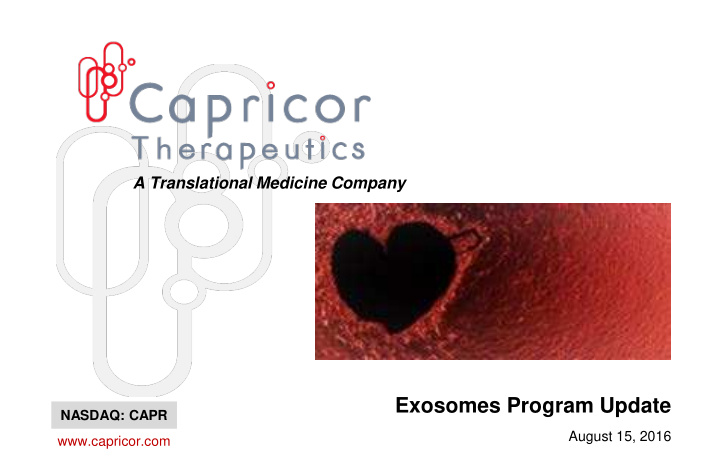



A Translational Medicine Company Exosomes Program Update NASDAQ: CAPR August 15, 2016 www.capricor.com
Forward-Looking Statements 2 This presentation contains forward-looking statements and information that are based on the beliefs of the management of Capricor Therapeutics, Inc. (Capricor) as well as assumptions made by and information currently available to Capricor. All statements other than statements of historical fact included in this presentation are forward-looking statements, including but not limited to statements identified by the words “anticipates,” “believes,” “estimates,” and “expects” and similar expressions. Such forward-looking statements also include any expectation of or dates for commencement of clinical trials, IND filings, similar plans or projections and other matters that do not relate strictly to historical facts. These statements reflect Capricor’s current views with respect to future events, based on what we believe are reasonable assumptions; however, the statements are subject to a number of risks, uncertainties and assumptions. There are a number of important factors that could cause actual results or events to differ materially from those indicated by such forward-looking statements. More information about these and other risks that may impact Capricor's business are set forth in Capricor's Annual Report on Form 10-K for the year ended December 31, 2015, as filed with the Securities and Exchange Commission on March 30, 2016, in its Registration Statement on Form S-3, as filed with the Securities and Exchange Commission on September 28, 2015 and in our Quarterly Report on Form 10-Q for the period ending March 31, 2016 as filed with the Securities and Exchange Commission on May 13, 2016. Should one or more of these risks or uncertainties materialize, or should underlying assumptions prove incorrect, actual results may vary materially from those in the forward-looking statements. Further, Capricor’s management does not intend to update these forward-looking statements and information after the date of this presentation.
Exosomes: Next-Generation Regenerative Medicine Platform 3 – Exosomes are extracellular vesicles secreted by CDCs that mediate their regenerative and cardioprotective effects Discovered in the course of elucidating CDCs’ mechanism of action – CDC Exosomes (CAP-2003) represent a potential cell-free regenerative medicine technology – Exclusive WW license to CDC Exosomes technology from Cedars-Sinai Medical Center – First clinical indication: Ocular graft-vs-host disease (oGVHD) Camussi et al, Kidney Int 2010 ; 78 :838–848.
Ocular GVHD – First Clinical Development Opportunity 4 – Graft-vs-host disease (GVHD) A common complication of bone marrow transplantation (BMT) Immune cells in graft recognize and attack host tissue Results in cell death, inflammation, and organ damage – Ocular GVHD is a common, debilitating form of chronic GVHD and represents a true unmet medical need Burning sensation in the eyes, irritation, photophobia, pain, dryness Current treatment options are limited Approximately 8,500 bone marrow transplants are performed in the U.S. annually oGVHD reported to occur in approximately 40% of BMT recipients ( ~3,400/yr ) Average survival following BMT is approximately five years – Capricor attended a pre-IND meeting with FDA at the end of July Expect to submit IND application for CAP-2003 in oGVHD in H1:17 http://bloodcell.transplant.hrsa.gov/about/general_faqs/index.html Shikari et al, Surv Ophthalmol. 2013 May-Jun;58(3):233-51.
Study of CAP-2003 in Model of Alkali Burn Injury 5 Sprague-Dawley rat model Alkali-induced burn on day 0 Product administration on day 1 – Vehicle – CAP-2003 subconjuctival injection (single) – CAP-2003 topical 3x/day Clinical score assessed on day 0, 4, 7, 14, 21 – Calculated from six parameters Histological analysis performed on day 21
CAP-2003 Demonstrated Significant Improvement 6 in Alkali Burn Injury Model – Clinical Score was calculated as the average of the sum of scores of six parameters (0-20): Conjunctival Injection (0-3) Corneal Area Affected (0-4) Aqueous Flare (0-4) Corneal Opacification (0-3) Corneal Neovascularization (0-2) Aqueous Cell (0-4) – Epithelial defect area was evaluated using fluorescein staining
A Translational Medicine Company NASDAQ: CAPR www.capricor.com
Recommend
More recommend